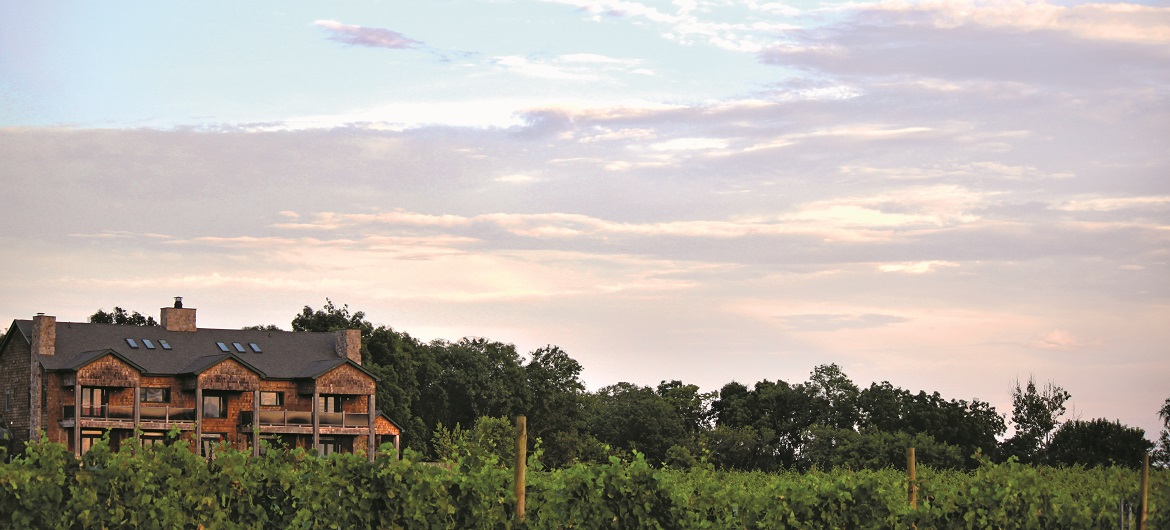
Cheers to Virginia Wine
By Lynn & Cele Seldon
More than two centuries ago, Thomas Jefferson envisioned vineyards surrounding his beloved Monticello estate near what is now Charlottesville, Virginia. He never saw his dream come to fruition during his lifetime, but he was very much correct in thinking that the Old Dominion could produce world-class wines in the New World.
Back then, Jefferson enlisted Italian Filippo Mazzei to research the region’s growing conditions and plant thousands of grape vines on land surrounding Monticello and at nearby farms. Their progress was delayed and then halted by a little matter called the American Revolution. Jefferson continued his efforts after the American Revolution, but environmental issues and diseases like the insect phylloxera again halted the progress Jefferson had hoped for.
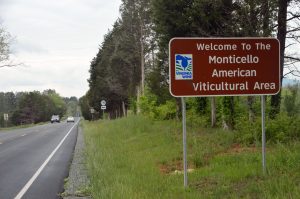
Photo courtesy of Seldon Ink
Renewed efforts in the early-1800s to make high-quality wines in Virginia were greatly enhanced in 1835 when Dr. D.N. Norton propagated a domestic native grape that would bear his name—and is still grown and used today. Norton was not susceptible to phylloxera and made great wines as the foundation of what became known as Virginia Claret. The then-Monticello Wine Company won a gold medal at an international competition in 1873 and a silver in Paris in 1878, earning the area around Jefferson’s Monticello the nickname of the “Rhine of America” and, later, the “Birthplace of American Wine.”
Further progress in coming decades again came to a halt, thanks to Virginia’s statewide prohibition in 1914 and national prohibition with the Volstead Act in 1920. The repeal of prohibition in 1933 brought short-lived progress before the Great Depression and World War II again slowed growth.
Another landmark moment in Virginia wines occurred in 1976 with the establishment of Barboursville Vineyards by founder Gianni Zonin, who was only in his tenth year as head of a family wine company in Northern Italy that had started in 1821. Zonin, along with his first winemaker Gabriele Rausse (who is now at her own winery below) and—starting in 1990—renowned award-winning winemaker Luca Paschina, would go on to put Virginia and the Monticello Wine Trail on the worldwide map of great wine regions to visit.
Today, Virginia is the fifth largest producer of wine in the United States and the Monticello Wine Trail is one of the best ways to explore the possibilities. The Jeffersonian Wine Grape Grower’s Society was established in the early-1980s and this was followed in 1984 with the establishment of Virginia’s third American Viticulture Area (AVA), as the Monticello AVA.
Nestled in the eastern slope of the Blue Ridge Mountains surrounding Charlottesville, the Monticello Wine Trail currently has more than 30 varied vineyards and wineries open for tours, tastings, dining, and more. The possibilities are unique at each location and many visitors choose to visit several over a period of one or more days in the area.
Situated about 30 minutes northeast of Charlottesville, Barboursville Vineyards is an appropriate place to start an exploration of the Monticello Wine Trail. Of course, there’s a popular tasting room and gift shop at the Winery and Visitors Center offering varied options for tasting and purchasing wine, but Barboursville offers much more to today’s visitor.
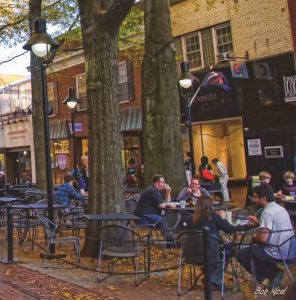
Downtown Charlottesville. Photo courtesy of Bob Mical
Further tasty and tasteful Barboursville options include several expanded or private tasting options (including intimate Library 1821), a phenomenal restaurant called Palladio that’s open for lunch Wednesday through Sunday and dinner Friday and Saturday only (reservations recommended), where executive chef and Virginia native Spencer Crawford uses ingredients grown on Barboursville’s grounds—including their own free-ranging small drove of Berkshire pigs for pork products exclusive to Palladio. Those who want to fully immerse themselves in Barboursville and the Monticello Wine Trail should consider exploring the ruins on the grounds and spending the night in the 1804 Inn, the Vineyard Cottage, the Sangiovese Cottage, or the Blue Run Cottage.
There are several other options nearby, including: another groundbreaking winery, Horton Vineyards (founder and Virginia wine pioneer Dennis Horton started a small home vineyard in 1983 and now produces dozens of different red, white, fruit, and dessert wines); Burnley Vineyards; Chestnut Oak Vineyard; and Reynard Florence Vineyard. Just to the south, Keswick Vineyards is well worth the easy diversion.
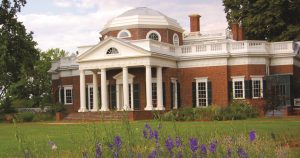
Monticello. Photo courtesy of Amy C. Evans
Heading south of I-64 and now to the southeast of Charlottesville proper, several other vineyards and wineries with equally interesting stories await visitors. First, almost in the shadow of Jefferson’s Monticello, Jefferson Vineyards is definitely a ‘must-see’ on the Monticello Wine Trail. As is to try the Meritage, a Bordeaux-style red blend that’s popular in Virginia and beyond.
Just down the road, Blenheim Vineyards features beautiful views from the tasting room and excellent wines. But, Blenheim is most known for being founded by Charlottesville’s Dave Matthews, whose Dave Matthews Band has sold millions of albums and played sold out shows around the world—and around the corner. Yet another excellent choice, Gabrielle Rausse Winery is also nearby.
A bit further afield to the southwest, well-respected Michael Shaps Wineworks and First Colony Winery are both recommended. First Colony also features Patina, a popular restaurant.
Heading west on I-64 past the exits for Charlottesville, more vineyards and wineries await on both the north and south sides of the interstate. To the south, heading down VA 29, Pippin Hill Farm & Vineyards is an excellent choice, with a great tasting room and views, plus tasty and creative lunches served Tuesday to Sunday. They also offer weekly cooking classes with Chef Scatena. Before the right-hand turn for Pippin Hill, be on the lookout for Albemarle Ciderworks, which is also on the right-hand side of the highway about a mile before the turn for Pippin Hill. For those in search of other imbibing choices, they are producing several enjoyable hard apple ciders at this pretty cidery.
Further to the west, many other interesting options near Route 151 include: Pollak Vineyards; Veritas Vineyard & Winery; Afton Mountain Vineyards (well worth the short drive up the mountainside); Cardinal Point Vineyard & Winery; and Flying Fox Vineyard. Route 151 is also at the center of the “Brew Ridge Trail” (see sidebar), which features several microbreweries.
North of I-64 and still west and northwest of Charlottesville, more than a half-dozen additional options await. Just off the interstate, King Family Vineyards continues to win awards with a variety of interesting wines, while Grace Estate Winery, Stinson Vineyards, and White Hall Vineyards are also great nearby stops. Further north, Glass House Winery, Stone Mountain Vineyards, Moss Vineyards, Kilaurwen Winery, and Early Mountain Vineyards up in Madison round out the possibilities in that direction.
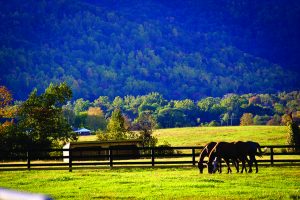
The Cville Vineyard. Photo courtesy of Michael Campbell
For those who do not want to appoint a designated driver, several local businesses provide excellent tour options where they do the driving (and guiding). These include: Top Shelf Transportation (www.topshelftransportation.com); Blue Ridge Wine Excursions (www.blueridgewineexcursions.com); Monticello Wine Tour and Coach Co. (www.monticellowinetour.com); Camryn Limousine Wine Tours (www.camryn-limo.com); Cville Tours (www.cvilletours.com); Indian Summer Guide Services (www.indiansummerguideservice.com; with unique horseback winery tours); and Cville Hop On Tours (www.cvillehopontours.com; including winery, brewery, cidery, and distillery tours).
Of course, downtown Charlottesville and the surrounding area has a number of tourist attractions beyond vineyards and wineries. The possibilities include: the fabled and historic grounds of the University of Virginia, including the Thomas Jefferson-designed Rotunda; Jefferson’s Monticello; James Monroe’s Highland; the Historic Downtown Mall; and Michie Tavern just down from Monticello, which was an authentic 18th century tavern and continues to be a tasty lunch choice.
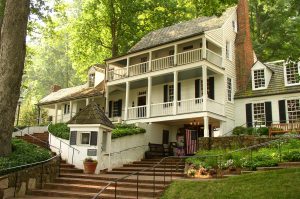
Michie Tavern. Photo courtesy of Bill McChesney
Along with Michie Tavern and varied winery dining options, tasty restaurants in the area (several featuring local wines and beers) include C&O Restaurant, The Whiskey Jar, and Citizen Burger Bar. There is also South Street Brewery (see “Brew Ridge Trail” sidebar), where they pour their own beers and serve locally-focused cuisine (like burgers using local ground beef) and Wild Wolf Brewery, where farm to glass beers and farm to fork meals also create great pairings.
Anytime is a great time to visit the Charlottesville area and the Monticello Wine Trail, including fall harvest season. However, springtime is also a great time to visit, thanks to early-April’s Taste of Monticello Wine Trail Festival. The weekend includes the annual Monticello Cup Wine Awards, activities at many local wineries, and a tasting event featuring more than two dozen local wineries and live entertainment. It’s a great time to say “cheers” to Virginia wines, the Monticello Wine Trail…and Thomas Jefferson.
When You Go
There are several helpful online resources for experiencing the Monticello Wine Trail, the Charlottesville area, and the rest of Virginia (including more award-winning wines), including: www.monticellowinetrail.com; www.monticellowinetrailfestival.com; www.visitcharlottesville.org; www.virginia.org; and www.virginiawine.org.

